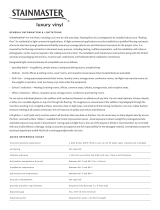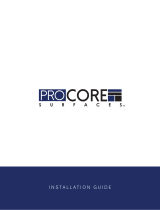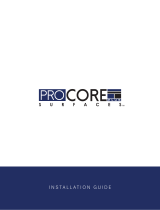Page is loading ...

CUTTING SEAM EDGES:
When cutting seams it is advisable to remove blades that are used for
trimming only. See Figure 1 below for blades to be removed.
CRAIN No. 290 SEAM CUTTER PLUS
ADJUSTING THE ROW GUIDE:
Loosen 3 screws to allow the row guide to move up or down (Figure 3).
Part the nap of the carpet with a row nder or separator. Set the base of
the cutter on the carpet with the extended row guide (Figure 3) inserted
into the parted row (Figure 4). With some downward pressure on the han-
dle of the tool, press the row guide down (Figure 3) to the bottom of the
row. Once the row guide depth is set, retighten the 3 screws.
NOTE: The row guide should ride on the bottom of the row when the
base is at on the face of the carpet (Figure 4). The base should not teeter
back and forth on the row guide. If it does, shorten the depth of the guide
until there is no rocking, yet the guide still contacts the bottom of the row.
LOOSEN ROW GUIDE SCREWS (3)
Figure 1
Figure 17
Figure 18
Figure 2
Figure 3
Figure 4
REMOVE
UTILITY
BLADES
FOR
TRIMMING
REMOVE
ROW
GUIDE
PRESS
DOWN ON
ROW GUIDE
TO BOTTOM
OF ROW.
BASE
FLAT ON
FACE OF
CARPET
PRESS HERE:
Loosen the two thumbscrews, which loosens the blade clamps. Install
two utility blades as shown in Figure 17.
INSTALLATION TIPS: Glue carpet within two feet of the molding.
Overlap unglued carpet over molding. Trim excess carpet using the tool.
Fold back the carpet, nish spreading adhesive, then tuck the carpet un-
der the lip of the molding for a perfect t.
Remove the two screws from the bottom of the base (Figure 15) in order
to remove the “close trim side” of the cutter (Figure 16). It is also neces-
sary to remove the seam cutting blade.
TRIMMING CARPET TO VINYL MOLDING:
When trimming, keep the edge of the cutter’s base pressed tight against
the inside edge of the vinyl molding (Figure 18). This will give you the
perfect amount of carpet to tuck underneath the vinyl molding.
UTILITY BLADE
INSTALLATION
BLADE
CLAMP
THUMB-
SCREWS
NUB
NUB
BLADE CLAMP
TYPES OF BLADES FOR SEAM CUTTING:
For seam cutting, the cutter will take either a slotted razor blade or a utility
blade. A slotted razor blade works well for cutting seam edges in carpets
with conventional backings or attached cushion. WARNING: It is not ad-
visable to extend a slotted razor blade more than 3/4” beyond the base.
For maximum cutting depth, use a utility blade. Utility blades are thicker
and less prone to undesired exing or breakage.
Figure 15 Figure 16

ADJUSTING THE CUTTING BLADE:
Adjust the bottom corner of the blade below the row guide approximately
the thickness of the carpet’s backing (Figure 6 & 7). Make test cuts and
perform necessary adjustments before proceeding.
TOP CUTTING WITHOUT THE ROW GUIDE:
When nding rows in a carpet is very difcult, the cutter can top cut
seams by overlapping the carpet at the seam area, then cutting through
both pieces of carpet from the top. Retract the row guide in the base.
Insert a utility blade, and adjust so that it extends far enough from the
base so it is able to cut the two carpet thicknesses (Figure 8). Plunge the
blade through the two pieces of carpet until the base rides at on the top
piece. Push forward and the cutter top cuts both seam edges. On certain
carpets, cutting in a serpentine motion can help disguise the seam (Figure
9). A test seam is often a good idea.
Retract the row guide and the seam cutting blade in the base (Figure 10).
Loosen the two thumb screws on the opposite side of the handle, which
loosens the blade clamps. Install two utility blades as shown in Figure 12.
Note that on the base there is a “close trim side” and a “wide trim side”
(Figure 13). The close trim side is for trimming Z-bar that is being installed
adjacent to a low elevation surface (Figure 13). The wide trim side is used
when installing carpet adjacent to an elevated surface, requiring the trim-
mer to be tilted over (Figure 14).
When trimming, keep the inside edge of the cutter’s base pressed tight
against the Z-bar. This will give you the perfect amount of carpet to fold
underneath the Z-bar once the trimming operation is complete.
LOOSEN ROW GUIDE SCREWS (3)
ROW
GUIDE
UTILITY BLADE
INSTALLATION
BLADE DEPTH:
CONVENTIONAL
BACKING
BACKING
THICKNESS
BLADE DEPTH:
ATTACHED
BACKING
BACKING
THICKNESS
BLADE
CLAMP
THUMB-
SCREW
NUB
NUB
BLADE CLAMP
THUMBSCREW
TRIMMING CARPET TO Z-BAR:
CLOSE
TRIM
SIDE
WIDE
TRIM
SIDE
CLOSE TRIM SIDE WIDE TRIM SIDE
PRESS UP
BLADE
DEPTH:
UTILITY BLADE
DOUBLE
CUTTING
Figure 6
Figure 8 Figure 9
Figure 7
Figure 10
Figure 11
Figure 12
Figure
13
Figure
14
Loosen the thumbscrew and insert a blade
through the base of the cutter all the way into the
blade clamp (Figure 5). NOTE: the thumbscrew
should always be positioned above the blade.
For seam cutting, the cutter can take either a
slotted razor blade or a utility blade. Extend the
blade beyond the row guide by the amount nec-
essary to cut through the carpet’s backing.
INSERTING BLADE FOR SEAM CUTTING:
Figure 5
BLADE
CLAMP
THUMB-
SCREW

ADJUSTING THE CUTTING BLADE:
Adjust the bottom corner of the blade below the row guide approximately
the thickness of the carpet’s backing (Figure 6 & 7). Make test cuts and
perform necessary adjustments before proceeding.
TOP CUTTING WITHOUT THE ROW GUIDE:
When nding rows in a carpet is very difcult, the cutter can top cut
seams by overlapping the carpet at the seam area, then cutting through
both pieces of carpet from the top. Retract the row guide in the base.
Insert a utility blade, and adjust so that it extends far enough from the
base so it is able to cut the two carpet thicknesses (Figure 8). Plunge the
blade through the two pieces of carpet until the base rides at on the top
piece. Push forward and the cutter top cuts both seam edges. On certain
carpets, cutting in a serpentine motion can help disguise the seam (Figure
9). A test seam is often a good idea.
Retract the row guide and the seam cutting blade in the base (Figure 10).
Loosen the two thumb screws on the opposite side of the handle, which
loosens the blade clamps. Install two utility blades as shown in Figure 12.
Note that on the base there is a “close trim side” and a “wide trim side”
(Figure 13). The close trim side is for trimming Z-bar that is being installed
adjacent to a low elevation surface (Figure 13). The wide trim side is used
when installing carpet adjacent to an elevated surface, requiring the trim-
mer to be tilted over (Figure 14).
When trimming, keep the inside edge of the cutter’s base pressed tight
against the Z-bar. This will give you the perfect amount of carpet to fold
underneath the Z-bar once the trimming operation is complete.
LOOSEN ROW GUIDE SCREWS (3)
ROW
GUIDE
UTILITY BLADE
INSTALLATION
BLADE DEPTH:
CONVENTIONAL
BACKING
BACKING
THICKNESS
BLADE DEPTH:
ATTACHED
BACKING
BACKING
THICKNESS
BLADE
CLAMP
THUMB-
SCREW
NUB
NUB
BLADE CLAMP
THUMBSCREW
TRIMMING CARPET TO Z-BAR:
CLOSE
TRIM
SIDE
WIDE
TRIM
SIDE
CLOSE TRIM SIDE WIDE TRIM SIDE
PRESS UP
BLADE
DEPTH:
UTILITY BLADE
DOUBLE
CUTTING
Figure 6
Figure 8 Figure 9
Figure 7
Figure 10
Figure 11
Figure 12
Figure
13
Figure
14
Loosen the thumbscrew and insert a blade
through the base of the cutter all the way into the
blade clamp (Figure 5). NOTE: the thumbscrew
should always be positioned above the blade.
For seam cutting, the cutter can take either a
slotted razor blade or a utility blade. Extend the
blade beyond the row guide by the amount nec-
essary to cut through the carpet’s backing.
INSERTING BLADE FOR SEAM CUTTING:
Figure 5
BLADE
CLAMP
THUMB-
SCREW

CUTTING SEAM EDGES:
When cutting seams it is advisable to remove blades that are used for
trimming only. See Figure 1 below for blades to be removed.
CRAIN No. 290 SEAM CUTTER PLUS
ADJUSTING THE ROW GUIDE:
Loosen 3 screws to allow the row guide to move up or down (Figure 3).
Part the nap of the carpet with a row nder or separator. Set the base of
the cutter on the carpet with the extended row guide (Figure 3) inserted
into the parted row (Figure 4). With some downward pressure on the han-
dle of the tool, press the row guide down (Figure 3) to the bottom of the
row. Once the row guide depth is set, retighten the 3 screws.
NOTE: The row guide should ride on the bottom of the row when the
base is at on the face of the carpet (Figure 4). The base should not teeter
back and forth on the row guide. If it does, shorten the depth of the guide
until there is no rocking, yet the guide still contacts the bottom of the row.
LOOSEN ROW GUIDE SCREWS (3)
Figure 1
Figure 17
Figure 18
Figure 2
Figure 3
Figure 4
REMOVE
UTILITY
BLADES
FOR
TRIMMING
REMOVE
ROW
GUIDE
PRESS
DOWN ON
ROW GUIDE
TO BOTTOM
OF ROW.
BASE
FLAT ON
FACE OF
CARPET
PRESS HERE:
Loosen the two thumbscrews, which loosens the blade clamps. Install
two utility blades as shown in Figure 17.
INSTALLATION TIPS: Glue carpet within two feet of the molding.
Overlap unglued carpet over molding. Trim excess carpet using the tool.
Fold back the carpet, nish spreading adhesive, then tuck the carpet un-
der the lip of the molding for a perfect t.
Remove the two screws from the bottom of the base (Figure 15) in order
to remove the “close trim side” of the cutter (Figure 16). It is also neces-
sary to remove the seam cutting blade.
TRIMMING CARPET TO VINYL MOLDING:
When trimming, keep the edge of the cutter’s base pressed tight against
the inside edge of the vinyl molding (Figure 18). This will give you the
perfect amount of carpet to tuck underneath the vinyl molding.
UTILITY BLADE
INSTALLATION
BLADE
CLAMP
THUMB-
SCREWS
NUB
NUB
BLADE CLAMP
TYPES OF BLADES FOR SEAM CUTTING:
For seam cutting, the cutter will take either a slotted razor blade or a utility
blade. A slotted razor blade works well for cutting seam edges in carpets
with conventional backings or attached cushion. WARNING: It is not ad-
visable to extend a slotted razor blade more than 3/4” beyond the base.
For maximum cutting depth, use a utility blade. Utility blades are thicker
and less prone to undesired exing or breakage.
Figure 15 Figure 16
/


